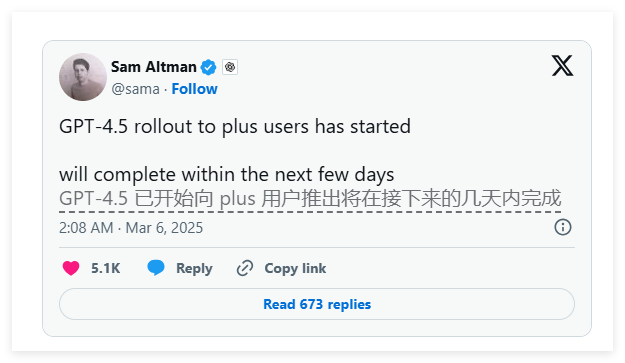OpenAI announced that it will begin rolling out its latest and largest artificial intelligence model - GPT-4.5 to ChatGPT Plus users. According to the company's arrangements, subscribers of ChatGPT Plus will gradually gain access to the model within the next one to three days. OpenAI CEO Sam Altman said that due to capacity constraints, initial user access will be controlled to manage user expectations.

GPT-4.5 is the largest artificial intelligence model of OpenAI to date. It uses more computing resources and data during training, aiming to improve the performance of the model in conversation tasks. Compared with previous versions, GPT-4.5 demonstrates better abilities in daily chat, practical problem solving and creative tasks, and may reduce the "illusion" phenomenon that occurred in past versions, that is, problems that generate inaccurate answers.
However, despite the improvement in GPT-4.5's performance in some areas, OpenAI admits that the model's capabilities in complex reasoning are still limited, far less than those of competitors such as Anthropic's Claude and DeepSeek's AI models. Altman made it clear on social media: "GPT-4.5 is not a reasoning model and cannot lead in benchmarks."
Users may be worried about the pricing issues of GPT-4.5. The model costs up to $150 per million generated tokens, which is 15 times more expensive than OpenAI's popular model GPT-4o. This significant price increase has raised doubts about its widespread adoption, especially given its shortcomings in logical reasoning and multi-step problem solving.
Despite these limitations, GPT-4.5 remains attractive. OpenAI internal testing showed that the model performed well in persuading other AI models, showing its excellent conversational abilities. In addition, GPT-4.5 also fully supports ChatGPT tools and APIs, providing developers with great flexibility.
Currently, the launch of GPT-4.5 highlights OpenAI's continued exploration of trade-offs, performance and real usability. Users who are eager to try this latest model will gain access in the next few days, and OpenAI will continue to evaluate how far and fast they can push on the technological boundaries.